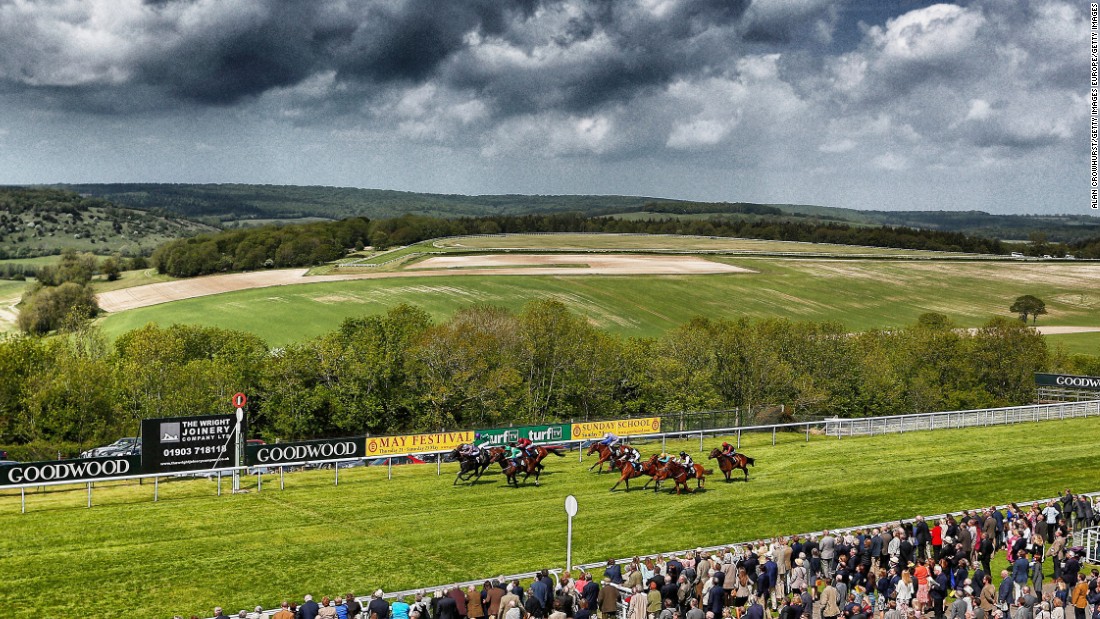It’s the ultimate expression of British upper-class culture — famously described by one king as “a garden party with racing tacked on.”
For two centuries, the cream of high society has flocked to Sussex Downs to celebrate a quintessentially English affair — the end of the summer social season.
“Glorious Goodwood takes place at the end of July and has traditionally been the last hurrah,” Celestria Noel, a consultant for peerage guide Debrett’s and herself a Lady of the aristocracy, tells CNN.
The horse racing festival in southern England, which starts Tuesday, bookends a period featuring prestigious society events such as Chelsea Flower Week, the Henley rowing regatta and the Wimbledon tennis championships, among others.
“The essence of Glorious Goodwood as a season event is that is the most summery,” Noel explains. “It’s always had a happy, carefree, light-hearted atmosphere like an end-of-term party — that relaxed feeling.”
Now officially known as the Qatar Goodwood Festival, it signals a period when members of the British social elite would begin to leave their country residences for the high life in London.
Royal affair
Launched in 1802 as a flat racecourse for local officers, Goodwood provides a five-day spectacle of racing with two Group One events, including the prestigious Sussex Stakes.
It has proven such a draw over the years that British monarchs have held important meetings in Goodwood House, the stately home in whose grounds the track sits, before nipping off to the racing.
As a result, Goodwood House is said to have had more meetings of the Privy Council — the British monarch’s appointed body of advisers — than any other private residence.
“The timing of race week was such that so many of the Privy Council were at Goodwood it was easier to have the meeting here than have everybody head back to London,” James Peill, curator of the Goodwood art collection, tells CNN.
Queen Elizabeth II held meetings in the 1950s, following on from George V in the 1920s and King Edward VII in the 1900s, in a house which is still privately owned by Lord March, the 10th Duke of Richmond.
Born Charles Gordon-Lennox, he also introduced the Goodwood Festival of Speed — dedicated to historic motor racing vehicles — but it is the other type of horse power that is celebrated by English society.
“It has got all the things that make it a season event,” says Sophie Campbell, author of “The Season: A Summer Whirl Through the English Social Season.”
“It has the history, the aristocratic connections, a stunning incredibly-English setting, and it has that chicness about the spectators which means that it is a double spectator event.
“People are not only watching the sport but watching each other — and that is one of the key things about a season event.”
Because of a sartorial twist by a king, it also has its own style.
In 1906, Edward VII — a Goodwood regular — caused a major shock by eschewing traditional morning dress (top hat and tailcoat) to attend the race in a white linen suit and a Panama hat.
Pretty soon, everyone had followed suit — quite literally — thus creating the relaxed ethos that defines Goodwood today.

Beautiful setting
Edward VII is also responsible for that garden party quote most used to describe Goodwood — which for him it was or, on occasion, a privy council meeting too.
Goodwood likes to market itself as the “world’s most beautiful course” — a bold statement, but one with which few disagree.
“When I was society editor of Harpers and Queen magazine, I traveled all over the world and I haven’t seen anything that has matched Goodwood for a sporting event, setting-wise,” Noel says.
“Except for maybe the Masters at Augusta, although that’s a bit different.”
The rolling greens may have different vistas, but Goodwood’s appeal is such that Qatar agreed a 10-year sponsorship deal in 2014 which means that prize money at the event is now worth $6.7 million.
The corporate world has kept the season alive, making it thrive when — by common consent — it was struggling for life nearly half a century ago.
“When I first started going to these things in the late ’70s, a lot of them were pretty dead on their feet — very elderly colonel-type members, huffing and puffing, and that was about it,” said Noel says.
Not anymore.
Thursday at Goodwood is Ladies’ Day and even though its style has been described as “garden party chic,” an event whose dress code is less strict than Henley and less flamboyant than Ascot does not lack in the fashion stakes.
“The style is a little more understated at Goodwood than Ascot, which has a huge spectacle of color but whose dress code is stricter,” says Emily Baxendale, Goodwood’s in-house milliner.
“Goodwood doesn’t have that — it’s more of a tacit understanding of quintessential British culture. For example, lots of people might wear a Panama, whereas Ascot is much more formalized with its top hats and tails,” adds Baxendale, who on Thursday will compete in the women-only Magnolia Cup charity race for the second time.
“At Goodwood, you don’t tend to get the huge supersized brims like you do at Ascot. Goodwood is much more full head pieces, Panamas, lovely beautiful hats — it’s much more relaxed, but still very stylish.
“It’s a very optimistic, positive, happy racing festival vibe. Where Ascot is more flamboyant, Goodwood is not quite so showy.
Nonetheless, there is still a desire to be seen — as per the demands of “The Season.”
“In continental Europe, they call it the ‘passeggiata’ — everyone comes out in the evening, and parades up and down the street in the early evening when it’s cooler,” Noel says.
“I definitely think the season is our British equivalent.”
As reported by CNN
